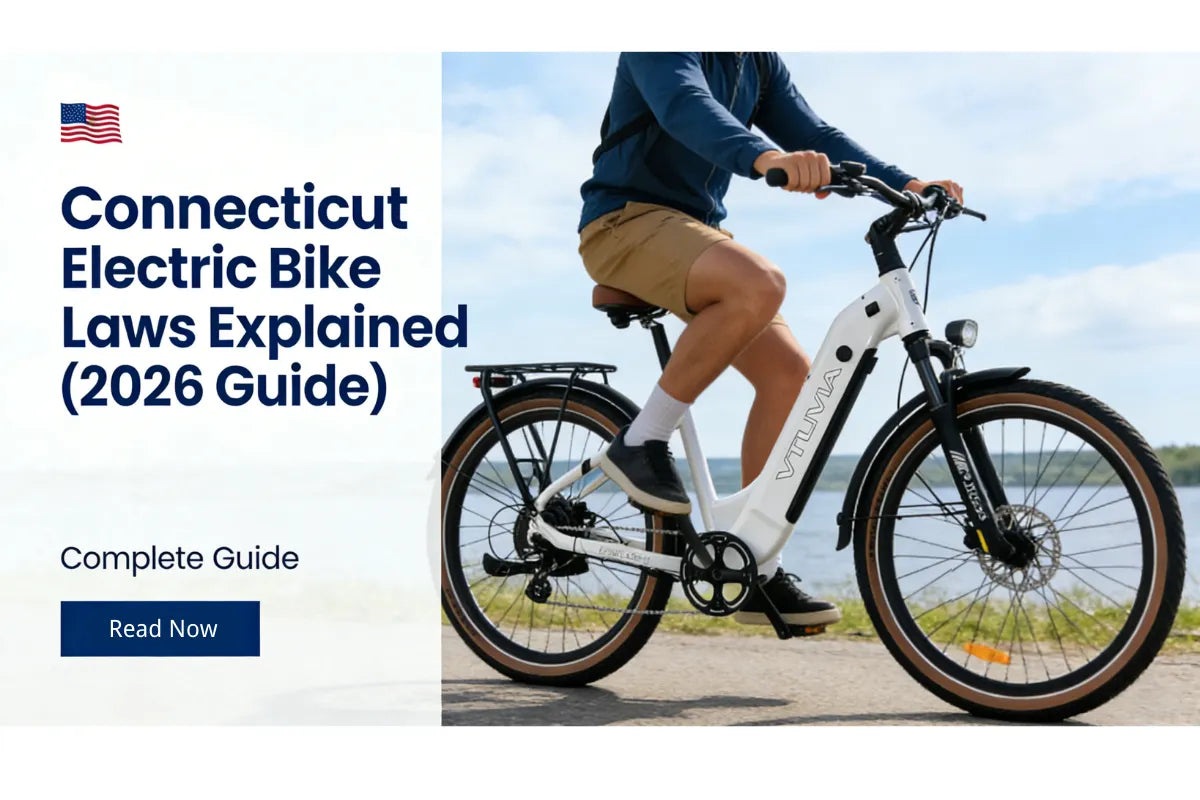Everything you need: practical math, real examples, charger selection, best daily habits, troubleshooting, and a built-in calculator so you can estimate your exact charging time.
1. Quick Answer
Typical range for charging a 48V eBike battery:
- Small pack (48V 10Ah / 480Wh) with a typical 2A charger: ≈ 4–6 hours to full; 2–4 hours to ~80%.
- Medium pack (48V 13Ah / 624Wh) with a 4A charger: ≈ 4–7 hours to full; 2.5–4.5 hours to ~80%.
- Large pack (48V 20Ah / 960Wh) with a 5A charger: ≈ 8–12 hours to full; 5–8 hours to ~80%.
Why two numbers? Because charging is fast up to 70–80% then tapers (the charger/BMS protects cells). Use the calculator below for exact estimates based on your pack & charger.
2. 48V Battery Basics & Key Terms
Before we run numbers, learn the small vocabulary that prevents mistakes.
- Voltage (V) — electrical potential. Your bike is rated 48V (nominal).
- Amp-hours (Ah) — how many amps a battery can provide for one hour (e.g., 13Ah).
-
Watt-hours (Wh) — the actual stored energy.
Wh = V × Ah. Example: 48V × 13Ah = 624Wh. - State of Charge (SoC) — % full (0–100%).
- Depth of Discharge (DoD) — percent used during a cycle.
- BMS — Battery Management System, the protective electronics that balance cells and limit currents.
- Charge taper / CC-CV — chargers use constant-current then constant-voltage: quick fill then slow top-up.
| Pack | Wh | Typical Use |
|---|---|---|
| 48V 10Ah | 480 Wh | Short urban commutes (15–30 miles depending on assist) |
| 48V 13Ah | 624 Wh | Daily commuting & longer errands (30–50 miles) |
| 48V 20Ah | 960 Wh | Long-range touring, cargo use (50–100 miles) |
3. How Charging Time Is Calculated (Practical Math)
Use this formula as a baseline — then apply realities (efficiency, tapering):
Ideal time (hours) = Battery capacity (Ah) ÷ Charger current (A)
But real chargers and BMS are not 100% efficient. Use an efficiency factor of 0.80–0.90 to account for losses and tapering.
Practical formula:
Estimated time to 100% = (Ah ÷ A) / EfficiencyFactor — where EfficiencyFactor ≈ 0.85
Worked examples
- 48V 13Ah / 4A charger → raw: 13 ÷ 4 = 3.25 h; with eff 0.85 → ≈ 3.8 hours to full.
- 48V 10Ah / 2A charger → raw: 10 ÷ 2 = 5 h; with eff 0.85 → ≈ 5.9 hours to full.
- 48V 20Ah / 5A charger → raw: 20 ÷ 5 = 4 h; with eff 0.85 → ≈ 4.7 h — but large packs often have longer taper (expect 6–10 h to true 100%).
Important: time to ~80% is significantly less because the CV (constant voltage) stage slows charging after ~70–80% SoC. For planning, use the calculator below and consider the "80% time" for daily use.
4. Factors That Change Real-World Charging Time
Charger specs
- Output current (A) — higher = faster (but must be supported by battery/BMS).
- Charger quality (real CC-CV profile, temperature compensation).
- Connector type & wiring resistance — cheap cable = more heat and slightly slower charge.
Battery & environment
- Age and internal resistance — older packs charge slower/hotter.
- Temperature: cold slows charging (BMS may refuse charge); heat also reduces safe charge current.
- Starting SoC — a 20%→80% charge is much quicker than 0%→100%.
Other real-world influencers
- BMS balancing near full charge — can add 30–90 minutes to top-off.
- Charger vs battery chemisty mismatch — never use an incompatible charger.
- Frequent fast-charging raises temperature and accelerates cell aging—short-term convenience vs long-term lifespan tradeoff.
5. Recommended Chargers & Realistic Setups
Pick the charger to match your needs and the pack's ratings. Below are practical recommendations.
Daily commuter (balanced life/charge)
- Pack: 48V 10–13Ah
- Charger: 2–4A (safe, gentle charging; overnight/top-up)
- Expected time: 3–7 hours to full; 1.5–4 hours to ~80%
Long-range / Touring
- Pack: 48V 16–20Ah
- Charger: 4–6A or use dual-swappable packs
- Expect longer tapering; plan overnight charging or a larger charger if pack supports it.
Fleet / rental (fast turnover)
- Use dedicated charger stations, spare packs, and a careful rotation policy to avoid fast-charging the same pack repeatedly.
- Consider chargers that report SoC and temperature to manage charging load.
What to avoid
- Using a charger rated higher than the pack/BMS allows — can damage cells or trip BMS.
- Cheap unbranded chargers without CC/CV control — risk of improper charging and reduced life.
6. Step-by-step Charging Protocol (Safe & Repeatable)
Before you charge
- Inspect the battery exterior and connector for damage or corrosion.
- Check charger model matches pack voltage (48V nominal) and current limit.
- If battery was just ridden hard, allow cool-down 15–30 minutes before charging.
- Plug charger into outlet, then connect to battery to reduce sparking in older plugs.
During charging
- Monitor charger LED/status during the first 20 minutes. Normal behavior: steady CC, then taper.
- Periodically feel the charger and battery temperature — normal is warm; hot is bad.
- If charger shows error or battery gets very hot (>60°C), unplug immediately and inspect.
After charging
- Wait a few minutes before disconnecting to let balancing finish.
- Store the battery in a cool dry place if not using immediately (recommended 40–60% SoC for storage).
- Log any irregularities (charging time, excessive heat) — helps troubleshoot aging packs.
7. Maintenance & Long-Term Battery Health
Daily / weekly habits
- Aim to keep SoC between 20–80% for frequent use; charge to 100% only when you need max range.
- Top-up short rides instead of full cycles when convenient.
- Keep pack and contacts clean and dry; wipe connectors after wet rides.
Storage
- Store at 40–60% SoC in a cool, dry place (10–20°C / 50–68°F ideal).
- Check and recharge to ~50% every 2–3 months during long storage.
When to replace
- Usable capacity falls below ~70–75% of original and impacts your daily use.
- Physical damage, swelling, or BMS faults — replace immediately.
8. Troubleshooting — Common Charging Problems & Fixes
| Symptom | Likely cause | Action |
|---|---|---|
| Charger LED does not light | Bad outlet, fuse, or charger | Try a different outlet, test with multimeter, replace charger |
| Charging stops early / error | BMS trip (temp or cell imbalance) | Allow cool-down, try again; if repeats, seek service |
| Long charging time | High internal resistance / cold temp / weak charger | Warm battery to room temp, test with proper charger, consider battery aging |
| Battery hot while charging | Excessive current or failing cells | Unplug immediately, allow to cool, inspect; service recommended |
9. Advanced Topics (for technicians & enthusiasts)
Fast charging realities
- Fast charging (higher A) shortens charge time but increases cell temperature and long-term aging.
- Only use fast chargers if the pack & BMS explicitly support the higher current.
BMS & smart chargers
Some charger/BMS combos communicate and provide smarter charge profiles — these can safely reduce charge time while protecting cells. Professional diagnostics can reveal if your pack supports higher currents.
Field balancing & repair
Cell balancing is typically handled by the BMS. Field re-balancing or cell replacement should be performed only by qualified technicians or the manufacturer service to avoid risks.
10. FAQs — Short Answers
- How long will a 48V 13Ah battery take to charge with a 4A charger?
- Estimate: 13 ÷ 4 = 3.25 h raw → ≈ 3.5–4.5 hours with losses and taper. Use calculator above for your exact setting.
- Can I leave my eBike charging overnight?
- Occasionally yes if charger has proper CC-CV and auto cut-off, but frequent overnight charging at 100% reduces long-term life. Use timers or charge to ~80% for daily use.
- Will fast charging ruin my battery?
- Fast charging increases heat and long-term degradation. If pack is rated for fast charging and you use it sparingly, it’s acceptable. Frequent fast-charging shortens battery lifespan.
- The charger gets hot — is that normal?
- Some warmth is normal. If it becomes very hot to touch, it may be overloaded or failing — unplug and inspect.
11. Printable Quick Checklist & Cheat Sheet
- ✔ Inspect connector & pack case for damage.
- ✔ Confirm charger matches 48V nominal and acceptable current.
- ✔ Allow pack to cool if recently used hard.
- ✔ Monitor LED/status; feel pack/charger temperature.
- ✔ If error, unplug and investigate.
- ✔ Aim for 20–80% SoC for regular use.
- ✔ Use manufacturer charger whenever possible.
Tip: Put a plug timer on the outlet to avoid accidental long stays at 100%.
12. Suggested References & Further Reading
(When publishing, link to manufacturer battery datasheets, independent lab tests, and authoritative battery chemistry resources.)
- Manufacturer battery datasheets (LG / Samsung cell datasheets).
- Independent eBike range & charging tests (magazine/lab reports).
- Battery safety standards (UL, IEC) and BMS whitepapers.
Want this as a printable PDF or a tailored checklist for a specific model? We can generate a one-page charging planner for your exact battery model — include battery specs and I'll produce the printable PDF.
Open Calculator




Share:
How to Test an Electric Bike Hub Motor at Home (Easy Step-by-Step Guide)
VTUVIA Black Friday 2025 Electric Bike Deals: Save Up to $600 + Free Gifts